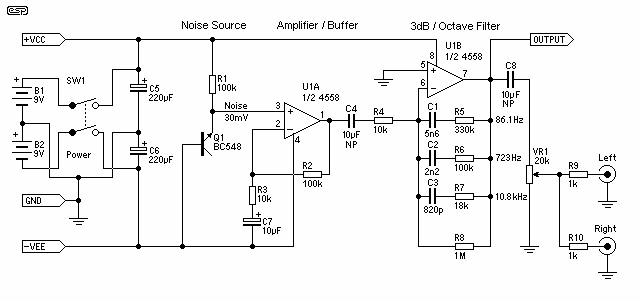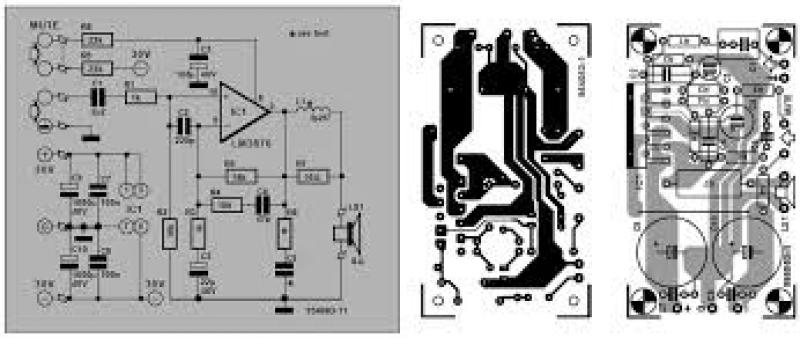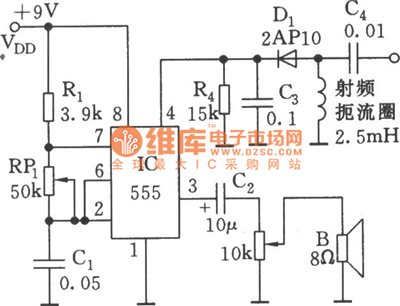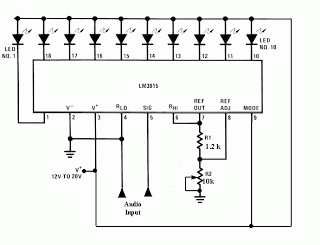
Audio noise generator
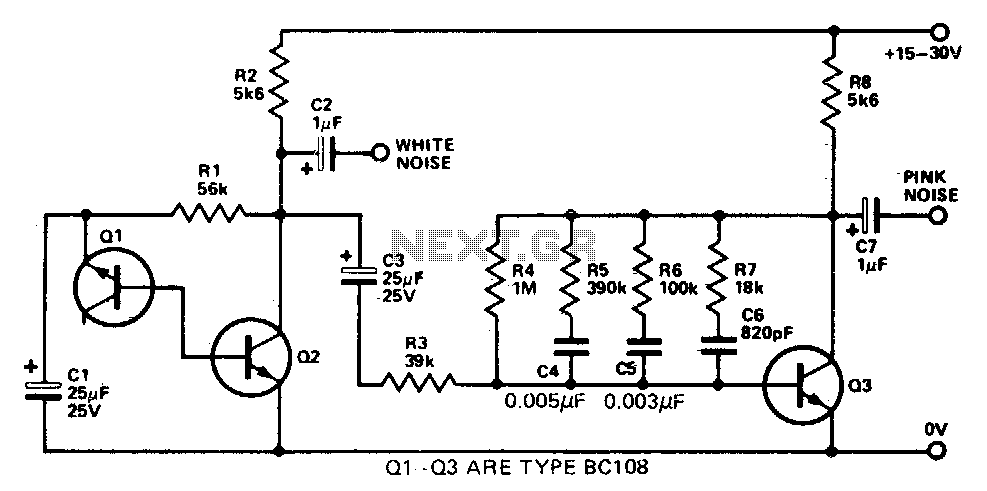
This simple circuit generates both white and pink noise. Transistor Q1 functions as a zener diode, with the base-emitter junction being reverse-biased to achieve zener breakdown at approximately 7 to 8 volts. The zener noise current from Q1 flows into the base of Q2, resulting in an output of about 150 millivolts of white noise. To convert the white noise to pink noise, a filter is necessary, which provides a 3 dB cut per octave as the frequency increases. Due to the significant attenuation caused by this filter, an amplifier is employed to restore the output level. Transistor Q3 serves as this amplifier, with the pink noise filter connected as a feedback network between the collector and base to control the gain versus frequency characteristics of the transistor. Consequently, the output from transistor Q3 is the required pink noise, which is fed to the relevant output socket.
This circuit operates on the principle of generating noise signals, utilizing transistors for amplification and filtering. The first stage involves Q1, which is configured to exploit its zener breakdown characteristics to produce white noise. The reverse-biasing of the base-emitter junction allows it to enter zener breakdown at a specified voltage, generating random noise due to thermal agitation and avalanche effects within the semiconductor material.
The generated white noise, characterized by a flat spectral density across frequencies, is then directed to the base of Q2. This transistor acts as a buffer, providing an output voltage of approximately 150 millivolts. The output at this stage retains the characteristics of white noise, which is suitable for further processing.
To achieve pink noise, which has equal energy per octave, a filter is implemented to attenuate higher frequencies. This filter is designed to provide a 3 dB reduction in amplitude for each octave increase in frequency, effectively shaping the noise spectrum to the desired pink noise profile. The filter's role is crucial, as it modifies the white noise signal to meet the requirements of applications that benefit from pink noise, such as audio testing and sound masking.
Given that the filtering process can significantly reduce the signal amplitude, an amplification stage is necessary to restore the output level. Q3 is introduced as an amplifier, with the pink noise filter strategically connected in a feedback configuration between its collector and base. This arrangement allows for precise control over the gain characteristics of the amplifier, ensuring that the output maintains the desired pink noise characteristics while compensating for any attenuation introduced by the filter.
The final output from Q3 is thus a robust pink noise signal, which can be utilized in various applications. The output socket is designed to interface with external devices or systems that require pink noise input, facilitating its use in practical scenarios such as audio engineering, acoustics research, and sound design. Overall, this circuit exemplifies a straightforward yet effective design for generating and processing noise signals.This simple circuit generates both white and pin noise. Transistor Q1 is used as a zener diode. The normal base-emitter junction is reverse-biased and goes into zener breakdown at about 7 to 8 volts. The zener noise current from Q G flows into the base of Q2 such that an output of about 150 millivolts of white noise is available.
To convert the white noise to pink, a filter is required which provides a 3 dB cut per octave as the frequency increases Since such a filter attenuates the noise considerably an amplifier is used to restore the output level. Transistor Q3 is this amplifier and the pink noise filter is connected as a feedback network, between collector and base in order to obtain the required characteristic by controlling the gain-versus-frequency of the transistor.
The output of transistor Q3 is thus the pink noise required and is fed to the relevant output socket. 🔗 External reference
This circuit operates on the principle of generating noise signals, utilizing transistors for amplification and filtering. The first stage involves Q1, which is configured to exploit its zener breakdown characteristics to produce white noise. The reverse-biasing of the base-emitter junction allows it to enter zener breakdown at a specified voltage, generating random noise due to thermal agitation and avalanche effects within the semiconductor material.
The generated white noise, characterized by a flat spectral density across frequencies, is then directed to the base of Q2. This transistor acts as a buffer, providing an output voltage of approximately 150 millivolts. The output at this stage retains the characteristics of white noise, which is suitable for further processing.
To achieve pink noise, which has equal energy per octave, a filter is implemented to attenuate higher frequencies. This filter is designed to provide a 3 dB reduction in amplitude for each octave increase in frequency, effectively shaping the noise spectrum to the desired pink noise profile. The filter's role is crucial, as it modifies the white noise signal to meet the requirements of applications that benefit from pink noise, such as audio testing and sound masking.
Given that the filtering process can significantly reduce the signal amplitude, an amplification stage is necessary to restore the output level. Q3 is introduced as an amplifier, with the pink noise filter strategically connected in a feedback configuration between its collector and base. This arrangement allows for precise control over the gain characteristics of the amplifier, ensuring that the output maintains the desired pink noise characteristics while compensating for any attenuation introduced by the filter.
The final output from Q3 is thus a robust pink noise signal, which can be utilized in various applications. The output socket is designed to interface with external devices or systems that require pink noise input, facilitating its use in practical scenarios such as audio engineering, acoustics research, and sound design. Overall, this circuit exemplifies a straightforward yet effective design for generating and processing noise signals.This simple circuit generates both white and pin noise. Transistor Q1 is used as a zener diode. The normal base-emitter junction is reverse-biased and goes into zener breakdown at about 7 to 8 volts. The zener noise current from Q G flows into the base of Q2 such that an output of about 150 millivolts of white noise is available.
To convert the white noise to pink, a filter is required which provides a 3 dB cut per octave as the frequency increases Since such a filter attenuates the noise considerably an amplifier is used to restore the output level. Transistor Q3 is this amplifier and the pink noise filter is connected as a feedback network, between collector and base in order to obtain the required characteristic by controlling the gain-versus-frequency of the transistor.
The output of transistor Q3 is thus the pink noise required and is fed to the relevant output socket. 🔗 External reference
